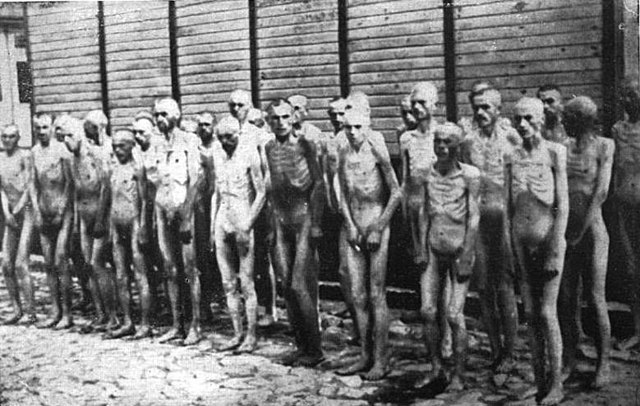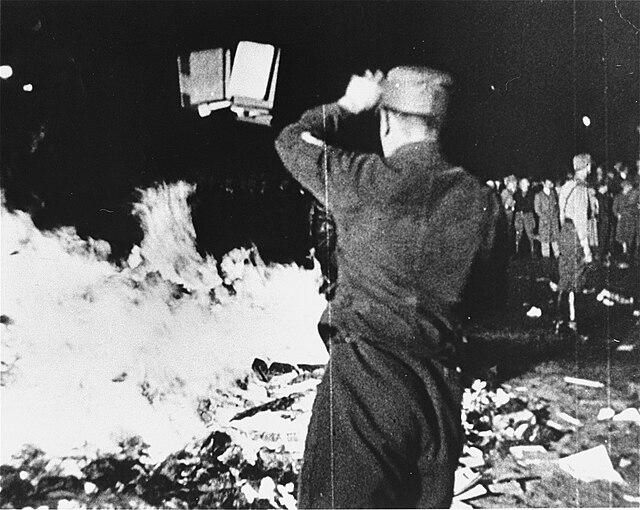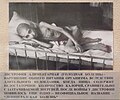Holocaust victims
person killed by Axis powers in a systematic campaign to exterminate European Jews From Wikipedia, the free encyclopedia
Remove ads
During the Holocaust, at least 6,000,000 Jews were killed by Nazi Germany, other Axis powers and their local collaborators.[1] The Jewish victims of the Holocaust were killed in Nazi extermination camps. Many others died in camps and ghettoes from diseases, man-made starvation, and freezing to death, caused by the terrible living conditions. Others in areas that Nazi Germany took over died from famine and other causes.[1]
Remove ads
Motives
Racialism
The Nazis believed that some races and ethnic groups were not as good as others. They thought the "Aryan race" was the best of all. They wanted Nazi Germany to be filled only with "Aryan" people.
The Nazis thought that there were some ethnic groups that were not even human. Two of these groups were the Jews and the Sinti and Roma People. The Nazis decided to kill all of the Jews and Sinti and Roma People in Nazi Germany. The Nazis also thought that Slavic peoples were less than human, and they killed millions of Slavs because of their ethnicity.
Remove ads
Holocaust victims
The Nazis thought of the Jewish people as an ethnic group. This meant that even if a person did not practice the Jewish religion, the Nazis still thought of them as Jewish.[2] Early on in World War II, the Nazis made Jewish people leave their homes and forced them to live in ghettos. However, by 1941, Adolf Hitler had decided to kill all of the Jews in Europe. This plan was called the Final Solution. Starting in 1942, the Nazis deported the Jews from the ghettos to death camps like Auschwitz. At these camps, people were killed in gas chambers as soon as they arrived.[3]
By the end of The Holocaust, one out of every three Jewish people in the world had died or been killed by the Nazis.[4] In Europe, only one out of every three Jews survived The Holocaust.[3] Many countries lost most of their Jewish populations. For example:[5][6]
- 3 million Polish Jews died or were killed (this was 90% of the Jews in Poland)
- 2.1 million Jews died or were killed in the Soviet Union
- Estonia, Latvia, Lithuania, Germany, and Austria all lost 90% of their Jewish populations
- Another eight countries lost over half of their Jewish populations: Bohemia and Moravia (89%); Slovakia (83%); Greece (77%); Netherlands (75%); Hungary (70%); Belgium (60%); and Yugoslavia (60%)
Over one million Jewish children died or were killed during the Holocaust.[7]
Remove ads
Other victims of Nazism
Slavs
The Nazis also caused the death of millions of Slavic people, including Poles, Serbs and Russians,[8] Ukrainians, Czechs, Bosniaks, and Sorbs. The Nazis thought Slavs were an inferior race. However, they also wanted to clear out the people in the Slavic countries, so there would be plenty of Lebensraum ("living space") for "Aryan" people.[9]
Poles
Poles were one of the groups whose population Hitler sought to reduce. He first shared this idea in 1939. On August 22, 1939, Hitler said:
[T]he [goal] of the war is ... to destroy the enemy. That is why I have prepared ... my 'Death's Head' [groups of soldiers] with orders to kill without pity or mercy all men, women, and children of Polish descent or language. Only in this way can we [get] the living space we need.[10]p.115
Before World War II, Poland had the largest population of Jews in Europe. By the end of the Holocaust, three million Polish Jews had died or been killed.[5]p. 403 So had 1.8 million to three million Poles who were not Jewish.[11]p. 305 These victims included:
- Hundreds of thousands of Roman Catholic and Orthodox Poles, who were sent to Auschwitz and other concentration camps[12]
- Scholars and other important people[12]
- Children of all ages[7]
Almost 17% of Poland's entire population died or was killed in The Holocaust.[10]
Ukrainians
Originally, the Nazis reportedly planned to reduce the 23.2 million people in Ukraine by 65% (about 15 million Ukrainians).[13][14] They planned to make the survivors work as slaves.[15]
Between 1941 and 1945, the Nazis killed about three million Ukrainians.[16][17] They also deported over two million Ukrainians to Germany to be used as slave workers.[18]
More Ukrainians were killed fighting the Wehrmacht in the Soviet Red Army than American, British and French soldiers all put together.[19]
Soviets

Mass murders of Soviet prisoners of war (POW) and civilians by the Germans in their occupied areas were common.[7] 3.3 million of the 5.7 million Red Army soldiers captured by the Germans did not survive the war.[20][21] The millions of Red Army POW were killed in several ways:
- German soldiers (especially the Waffen-SS) executed them after they were captured
- Many Soviet POWs died because of terrible conditions in German prisoner of war camps, or on death marches
- The Nazis sent many Soviet POWs to concentration camps to be killed
In eight months between 1941-1942, the Nazis killed about 2.8 million Soviet POWs by execution, starvation, and freezing to death.[22]
After the Nazis occupied parts of the Soviet Union, they treated Soviet civilians terribly. During the siege of Leningrad, more than 1.2 million civilians died. Nazi soldiers destroyed thousands of peasant villages across Russia, Belarus, and Ukraine. In 1995, the Russian Academy of Sciences reported that the Nazis caused 13.7 million civilian deaths in the occupied Soviet Union, including Jews.[23] This was 20% of the area's population. These deaths included:[23]
- 7.4 million victims of Nazi genocide and reprisals
- 2.2 million deaths of persons deported to Germany as forced labor
- 4.1 million deaths from famine and disease
About three million people also died of starvation in areas that the Nazis had not taken over.[23]

Roma and Sinti people
Under the Nazis' Nuremberg Laws, the Sinti and Roma people were called "enemies of the race-based [Germany]," just like Jews. Like with the Jews, the Nazis wanted to kill all of the Roma and Sinti people in Europe.[24]
In 1936, the Nazis began deporting Roma and Sinti people, first to areas on the outside edges of cities, and later to the same ghettoes that Jews were sent to. In 1942, Heinrich Himmler ordered that the Roma and Sinti people (including children) should be sent to Auschwitz concentration camp.[25] The Nazis also sent many Roma and Sinti adults and children to other death camps, like Bełżec, and to other concentration camps, like Ravensbrück.[7][26]
Historians estimate that 220,000 to 500,000 Roma and Sinti were killed by the Nazis. This was about one in every four Roma and Sinti people who lived in Europe at the time.[24] However, one researcher says that as many as 1.5 million Roma and Sinti may have died during The Holocaust.[27]
After World War II, it took a long time for countries to admit that Nazi Germany had committed a genocide against the Roma and Sinti people. In 1982, West Germany admitted that a genocide of the Roma had happened.[28][29] In 2011, the Polish Government ruled that Poland would honor the Roma genocide every year on the 2nd of August.[30]
Disabilities
The Nazis believed that people with disabilities were "life unworthy of life," and that they did not deserve to live. People with disabilities also did not fit into the Nazis' ideas about having a race of perfect "Aryans." The Nazis forced about 375,000 people to be sterilized so they could not have children with disabilities.[31] These people included people with physical disabilities, mental illnesses, intellectual disabilities, and the Deaf.[32]
People with disabilities were the first people the Nazis killed in gas chambers. In 1939, the Nazis set up a "euthanasia" program called Aktion T4. As part of this program, the Nazis sent children and adults with disabilities to hospitals like Hartheim Euthanasia Centre, where they were killed with poison gas. They also killed some children with disabilities right after they were born.[7] When the war ended, the Nazis had killed about 275,000 disabled people.[33] About 5,000 to 7,000 of these victims were children.[7]
Homosexuality

Lesbian, gay, bisexual, and transgender people were also victims of The Holocaust. The Nazis were especially cruel to gay men. They thought that homosexual people hurt Nazi Germany in a few ways:[35][36]
- The Nazis thought gay men were too weak and too much like women to be able to fight for Nazi Germany
- The Nazis wanted "Aryan" Germans to have as many children as possible, but gay men would not be creating children
- The Nazis thought homosexuality was contagious, and that other Germans would become homosexual just by being around gay people
By 1936, Heinrich Himmler was trying to use Germany's laws, and make new laws, to persecute gay men. At least 100,000 gay German men were arrested, and 50,000 were convicted and put in prison.[37] Some were forced into state-run psychiatric hospitals. Courts ordered hundreds of European gay men living in Nazi-controlled areas to be castrated with chemicals.[38]
Between 5,000 and 15,000 gay men were imprisoned in concentration camps.[38][39] They were often treated even worse than other prisoners.[40] They had to wear a pink triangle on their shirts, just like men convicted of sexually abusing children and having sex with animals.[41]
Lesbians were not usually treated as badly as gay men. They were usually not put in prison just because they were lesbians. In the concentration camps, they usually wore a black triangle.[42]
According to the United States Holocaust Memorial Museum, "Nazi Germany did not seek to kill all homosexuals. Nevertheless, the Nazi state, through active persecution, attempted to terrorise German homosexuals into sexual and social conformity, leaving thousands dead and shattering the lives of many more."[38] They wanted to scare German homosexuals into conforming, or acting like the rest of society.
After World War II, many homosexuals who were liberated from the concentration camps were still persecuted in Germany. They could be charged under Paragraph 175, a law which made "lewdness between men" illegal. If they were convicted, they would be sent to prison. (The time they spent in the concentration camps would be subtracted from their sentences.) This was very different from how other Holocaust victims were treated. Other victims were compensated (given money) for the loss of family members and educational opportunities.[43] Gay victims were treated like criminals.
Political prisoners
The Nazis also killed many people who did not agree with the Nazis' political beliefs. They thought of these people as political enemies of Nazi Germany.

The Nazis were especially cruel to people who spoke out or fought against the Nazi government. When they arrested these people, the Nazis often killed them right after questioning them. Sometimes, the Nazis killed their families too. People who were not killed right away were sent to the political People's Court. This court was famous for the number of death sentences it gave.[44]
Leftists
The Nazis thought of leftists as political enemies. Leftists included anarchists, communists, socialists, liberals, libertarians and Social Democrats. German communists and Social Democrats were some of the first people to be sent to Dachau concentration camp.[45][46] The Nazi Party hated communism, and was worried that German communists would be loyal to the Soviet Union, a communist country. The Nazis spread rumors about communist violence to get the Enabling Act of 1933 passed. This law gave Adolf Hitler his first powers as a dictator.
Hitler and the Nazis also hated German leftists because they did not agree with the Nazis' racism. When the Nazis took over a place, communists, socialists, liberals and social democrats were usually some of the first people they abused. Sometimes they would murder leftists right away.[47]
Religion
Jehovah's Witnesses
As part of their religious beliefs, Jehovah's Witnesses refused to serve in the German Army, salute the Nazi flag, or say "Heil Hitler" ("Hail Hitler").[48][49] They refused to go along with Nazi beliefs and laws that went against their religious beliefs.[49][50]
Because of this, many Jehovah's Witnesses were sent to concentration camps. Between 2,500 and 5,000 Witnesses died in the concentration camps.[51]
Roman Catholics

The Nazis also attacked the Catholic Church during The Holocaust.[52] Hitler wanted to destroy Catholicism and Christianity in Nazi Germany, and make Nazi Germany pagan instead.[53] Thousands of German clergy, nuns, and Catholic leaders were arrested after the Nazis took over.[54]
In 1939, Hitler invaded Poland, beginning World War II. Poland was mostly Catholic. The Nazis wanted to destroy Poland. They started by destroying the Catholic Church in Poland. They arrested the Church's leaders and closed churches and monasteries. In 1940, the Nazis created a special barracks just for priests at Dachau concentration camp.[55] Of 2,720 clergy imprisoned at Dachau, almost all (94.88 percent) were Catholic.[56] About 1,700 were Polish priests; half of them died or were killed at Dachau.[57] The Nazis even made it illegal for priests anywhere to give Catholic sacraments to Polish people. At least one German priest was sent to Dachau for taking a confession from a Polish Catholic.[58]
In 1933, Germany had made an agreement with the Holy See to protect Catholicism in Nazi Germany. However, the Nazis often broke this agreement.[59] They shut down the Catholic press, schools, political parties and youth groups in Germany amid murder and mass arrests.[60][61][62]
The Church was treated especially badly in lands that Germany took over. In Austria, Catholic property was taken, Catholic organizations were closed, and many priests were sent to Dachau. In Czechoslovakia, the Nazis refused to let people follow religious orders; closed schools; made religious teachings illegal; and sent priests to concentration camps.[63] Catholic people, bishops, clergy, and nuns protested and attacked Nazi policies.
In 1942, Dutch bishops protested the mistreatment of the Jews.[64] When the Dutch Archbishop refused to obey the Nazis, the Gestapo rounded up Catholic "Jews" and sent 92 to Auschwitz[65] A Dutch Catholic nun named Edith Stein was murdered at Auschwitz. So was Maximilian Kolbe, a Polish priest. Both were eventually made into Catholic saints by Pope John Paul II in the 1980s. Other Catholic victims of the Holocaust have also been beatified, including some of the Polish priests who died at Dachau.[66]
Protestants

Some Protestant Churches agreed with Nazi ideas. Others did not. Trying to take over Protestantism in Germany, the Nazis formed the National Reich Church: an official state church that taught a state religion based on Nazism.[58] The Reich Church:[67]
- Took away all Christian crosses and replaced them with the Nazi swastika
- Fired all clergy members and replaced them with Nazi speakers
- Demanded that the Bible never be printed in Germany again
- Put Hitler's book Mein Kampf on the altars of all its churches
They fired all clergy members who were not "Aryan." Church members called themselves "German Christians" and said they had "the swastika on their chest and the cross in their heart."[48][68]
Protestant groups that disagreed with Nazi ideas formed the Confessing Church, a group of German churches. Martin Niemöller was one or their leaders. Nazis persecuted the Confessing Church.[68] In May 1936, the Confessing Church sent a letter to Hitler criticizing his actions. The Nazis reacted by:[69]
- Arresting hundreds of pastors
- Sending some of the Confessing Church's leaders to concentration camps
- Taking all of the Confessing Church's money
- Making it illegal for the Confessing Church's members to give money to the Church
Most pastors and churches were not members of either the Reich Church or the Confessing Church.[58] Pastors who spoke out against what the Nazis were doing were threatened, arrested, and sometimes sent to concentration camps.[58]
Bahá'í Faith
In 1937, the Nazis made it illegal to practice the Bahá'í Faith. The Nazis closed all Bahá'í organizations in Germany.[70] The Nazis did not like the Bahá'í Faith because it taught pacifism.[71]
Throughout the Holocaust, Bahá'ís were arrested and given very expensive fines. The Nazis also continued to close their organizations.[72]
Freemasons
The Nazis blamed Freemasonry for Germany losing World War I. They said the Freemasons' leaders were part of a conspiracy with Jewish people to take over Germany.[73] In 1941, Adolf Hitler decided that Masons were political enemies. The Nazis sent tens of thousands of Masons to concentration camps. Between 80,000 to 200,000 Freemasons were killed.[74]
Remove ads
Total deaths of Nazi genocides
This table estimates the total number of victims of Nazi genocides.

Remove ads
Gallery
- Disabled children who will be killed by the Nazis (1934)
- Home movie from Vienna, taken after Kristallnacht (1938)
- Nazis burn a Lithuanian synagogue (1941)
- A Soviet civilian starving to death because of the Nazis' siege of Leningrad
- Public execution of Polish civilians (1942)
- American POWs killed by the Nazis in Belgium (1944)
- Ukrainian Jews shot by the Nazis
- Serbs being executed at Jasenovac concentration camp
Remove ads
References
Wikiwand - on
Seamless Wikipedia browsing. On steroids.
Remove ads












